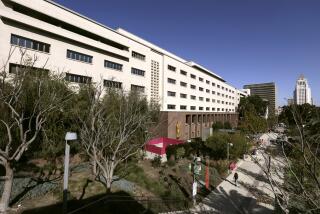Downsizing County-USC Makes Sense : Money is the crux; federal seed money will help replace a hospital critical for the poor
- Share via
What should be done with the deteriorating County-USC Medical Center? Proposals have ranged from a total shutdown of the mammoth facility, which was damaged in the Northridge earthquake, to rebuilding it. Based on recommendations from a new report, Los Angeles County would be served best by replacing-- and downsizing--the hospital, providing far fewer beds.
Resolving the fate of County-USC this way would involve less cost and fewer risks. At the same time, a new and smaller hospital would fit in with the county’s move toward expanding outpatient care and away from a system centered on hospitalizing patients.
Maintaining a medical facility in the East Los Angeles area is crucial because the nearest public hospital is several miles away. Nearby private hospitals have indicated that they will not be able to absorb all the patients served by County-USC should it be closed. Finally, a smaller medical center would give the county greater flexibility given all the uncertainties it faces in health-care financing.
For years the county has been planning to build a new County-USC hospital as part of a $2.2-billion plan to replace or upgrade its vast public hospital system. But faced with continuing budget problems, the Board of Supervisors sought an outside review of hospital projects. The study by Harvey M. Rose, which cost $480,000, recommended that the county downsize the replacement hospital it had planned. Rose said that a 788-bed hospital would be a better alternative than 946-bed facility originally planned. County-USC is licensed for 2,045 beds but uses only 1,000 of them now. The Rose report said that the county Department of Health Services could save between $31 million and $46 million annually if County-USC was replaced.
Supervisor Gloria Molina, whose district includes County-USC and who has faced the most political heat over its fate, is supporting a downsized replacement for the hospital. But she rightly points out that the problem now, as always, is how will the county finance a new hospital? The Rose report put the cost of constructing a 788-bed facility at $1.05 billion, compared with $1.32 billion for a 946-bed facility, including seismic upgrades. The Rose report recommended that funding assumptions used by the Department of Health Services be re-examined and adjusted to factor in new cutbacks in state and federal funding for health care.
A positive development last Friday was news from James Lee Witt, director of the Federal Emergency Management Agency, that $300 million in earthquake damage funds requested by County-USC can be used for “any alternative building.” That will hardly be enough. But it’s a start for a public hospital that is invaluable not only for the poor but for services that would be desperately needed after an earthquake or other calamity.
More to Read
Sign up for Essential California
The most important California stories and recommendations in your inbox every morning.
You may occasionally receive promotional content from the Los Angeles Times.










